BSC Business Management Exam Paper on Business Environment
VerifiedAdded on 2023/06/05
|9
|3261
|83
AI Summary
This exam paper for BSC Business Management covers topics such as Monetary Policy Committee, Fiscal Policy, Supply-side policies, Economic Cycle, and the impact of Covid-19 lockdown on the UK economy. It also discusses sustainable economic growth and methods to measure economic growth. The paper includes questions and answers with relevant examples.
Contribute Materials
Your contribution can guide someone’s learning journey. Share your
documents today.
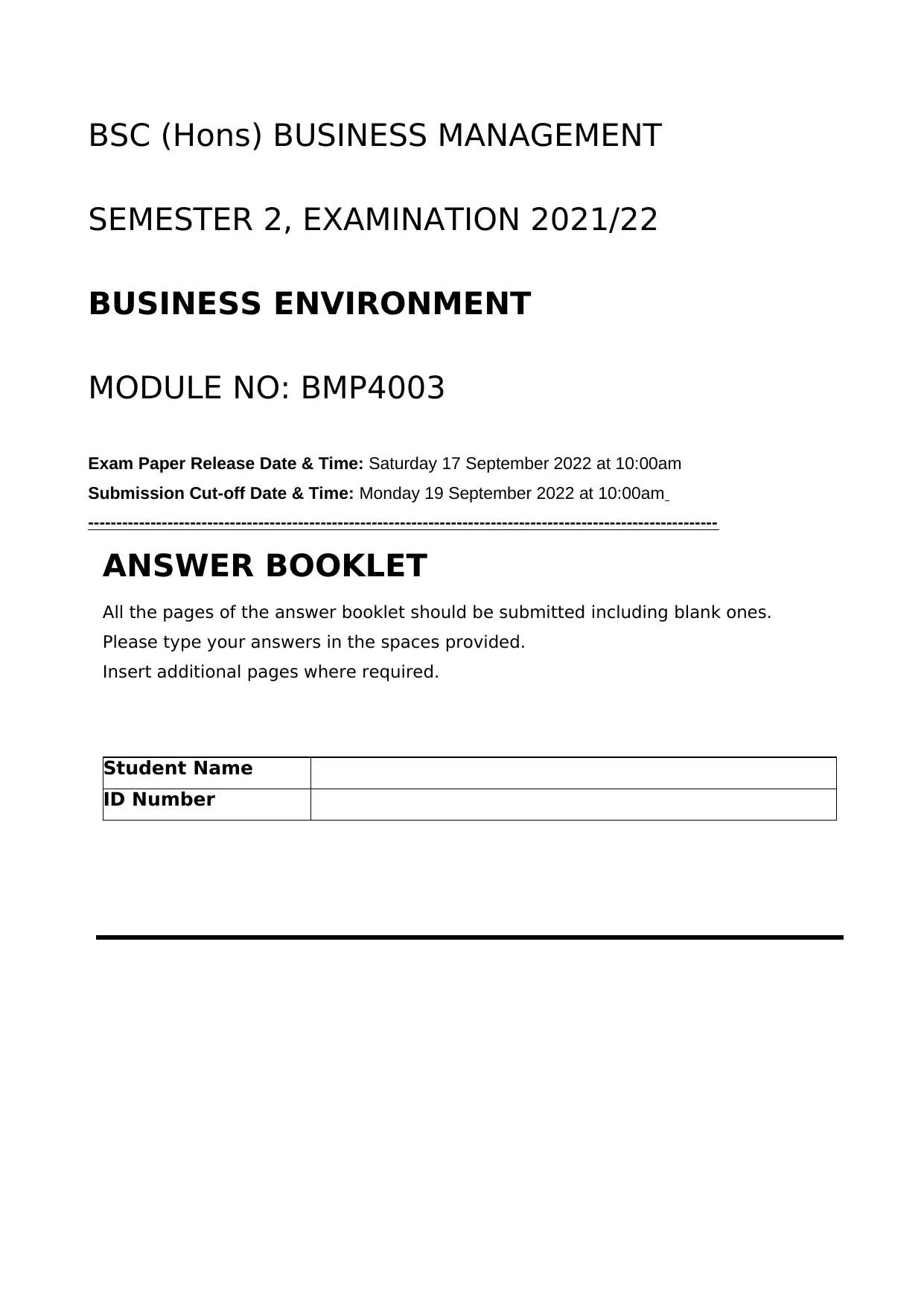
BSC (Hons) BUSINESS MANAGEMENT
SEMESTER 2, EXAMINATION 2021/22
BUSINESS ENVIRONMENT
MODULE NO: BMP4003
Exam Paper Release Date & Time: Saturday 17 September 2022 at 10:00am
Submission Cut-off Date & Time: Monday 19 September 2022 at 10:00am
---------------------------------------------------------------------------------------------------------------
ANSWER BOOKLET
All the pages of the answer booklet should be submitted including blank ones.
Please type your answers in the spaces provided.
Insert additional pages where required.
Student Name
ID Number
SEMESTER 2, EXAMINATION 2021/22
BUSINESS ENVIRONMENT
MODULE NO: BMP4003
Exam Paper Release Date & Time: Saturday 17 September 2022 at 10:00am
Submission Cut-off Date & Time: Monday 19 September 2022 at 10:00am
---------------------------------------------------------------------------------------------------------------
ANSWER BOOKLET
All the pages of the answer booklet should be submitted including blank ones.
Please type your answers in the spaces provided.
Insert additional pages where required.
Student Name
ID Number
Secure Best Marks with AI Grader
Need help grading? Try our AI Grader for instant feedback on your assignments.
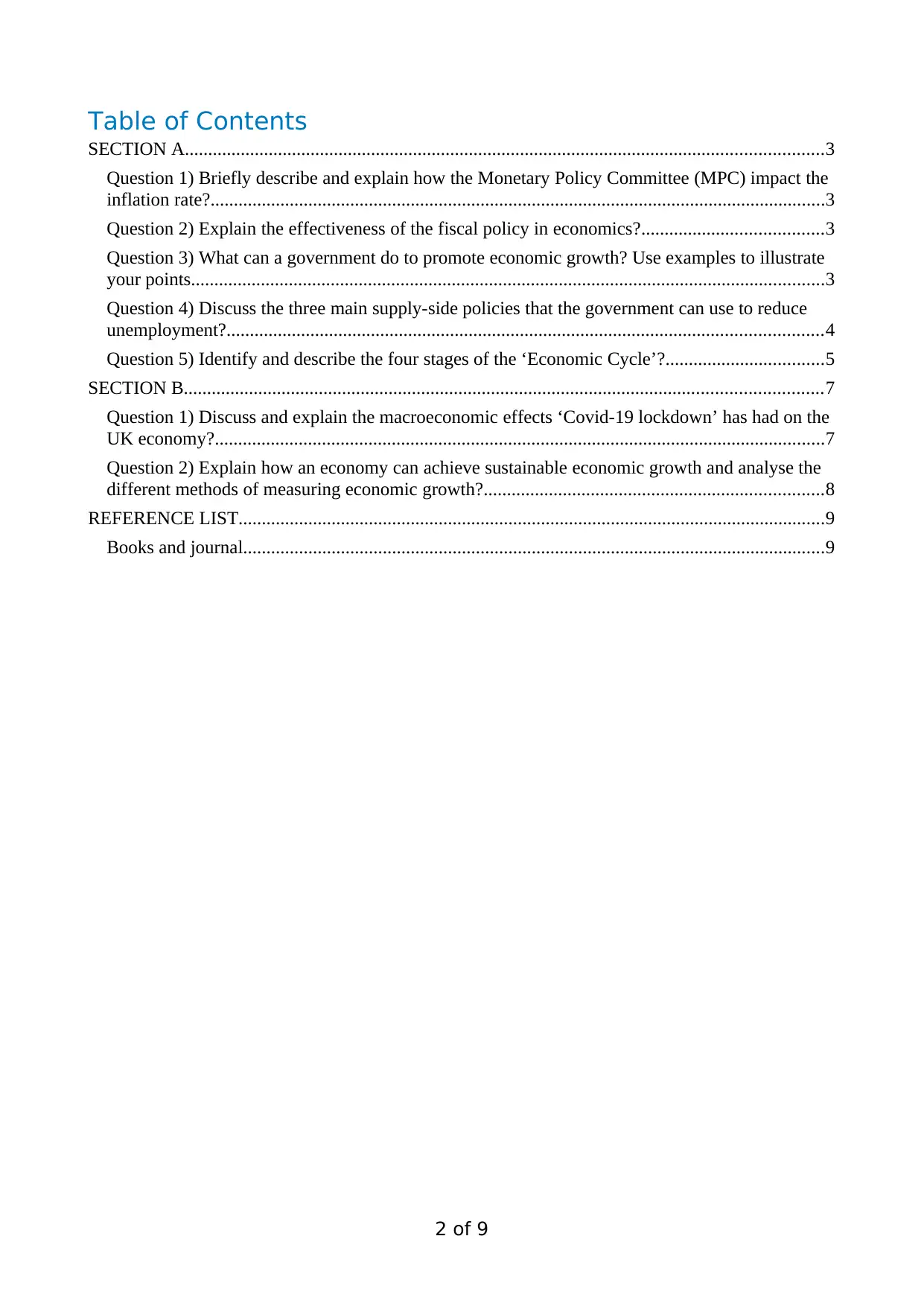
Table of Contents
SECTION A.........................................................................................................................................3
Question 1) Briefly describe and explain how the Monetary Policy Committee (MPC) impact the
inflation rate?....................................................................................................................................3
Question 2) Explain the effectiveness of the fiscal policy in economics?.......................................3
Question 3) What can a government do to promote economic growth? Use examples to illustrate
your points........................................................................................................................................3
Question 4) Discuss the three main supply-side policies that the government can use to reduce
unemployment?................................................................................................................................4
Question 5) Identify and describe the four stages of the ‘Economic Cycle’?..................................5
SECTION B.........................................................................................................................................7
Question 1) Discuss and explain the macroeconomic effects ‘Covid-19 lockdown’ has had on the
UK economy?...................................................................................................................................7
Question 2) Explain how an economy can achieve sustainable economic growth and analyse the
different methods of measuring economic growth?.........................................................................8
REFERENCE LIST..............................................................................................................................9
Books and journal.............................................................................................................................9
2 of 9
SECTION A.........................................................................................................................................3
Question 1) Briefly describe and explain how the Monetary Policy Committee (MPC) impact the
inflation rate?....................................................................................................................................3
Question 2) Explain the effectiveness of the fiscal policy in economics?.......................................3
Question 3) What can a government do to promote economic growth? Use examples to illustrate
your points........................................................................................................................................3
Question 4) Discuss the three main supply-side policies that the government can use to reduce
unemployment?................................................................................................................................4
Question 5) Identify and describe the four stages of the ‘Economic Cycle’?..................................5
SECTION B.........................................................................................................................................7
Question 1) Discuss and explain the macroeconomic effects ‘Covid-19 lockdown’ has had on the
UK economy?...................................................................................................................................7
Question 2) Explain how an economy can achieve sustainable economic growth and analyse the
different methods of measuring economic growth?.........................................................................8
REFERENCE LIST..............................................................................................................................9
Books and journal.............................................................................................................................9
2 of 9
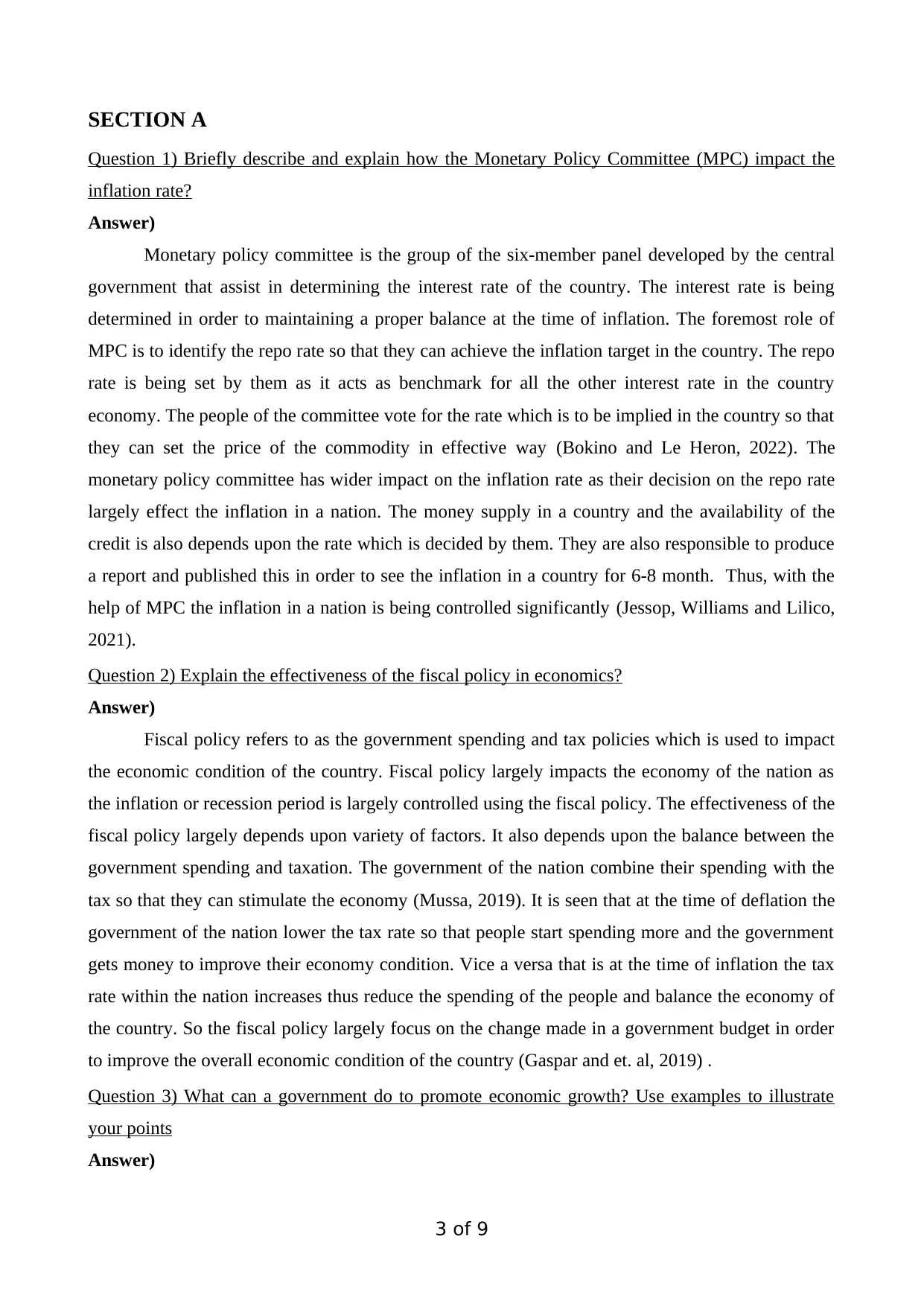
SECTION A
Question 1) Briefly describe and explain how the Monetary Policy Committee (MPC) impact the
inflation rate?
Answer)
Monetary policy committee is the group of the six-member panel developed by the central
government that assist in determining the interest rate of the country. The interest rate is being
determined in order to maintaining a proper balance at the time of inflation. The foremost role of
MPC is to identify the repo rate so that they can achieve the inflation target in the country. The repo
rate is being set by them as it acts as benchmark for all the other interest rate in the country
economy. The people of the committee vote for the rate which is to be implied in the country so that
they can set the price of the commodity in effective way (Bokino and Le Heron, 2022). The
monetary policy committee has wider impact on the inflation rate as their decision on the repo rate
largely effect the inflation in a nation. The money supply in a country and the availability of the
credit is also depends upon the rate which is decided by them. They are also responsible to produce
a report and published this in order to see the inflation in a country for 6-8 month. Thus, with the
help of MPC the inflation in a nation is being controlled significantly (Jessop, Williams and Lilico,
2021).
Question 2) Explain the effectiveness of the fiscal policy in economics?
Answer)
Fiscal policy refers to as the government spending and tax policies which is used to impact
the economic condition of the country. Fiscal policy largely impacts the economy of the nation as
the inflation or recession period is largely controlled using the fiscal policy. The effectiveness of the
fiscal policy largely depends upon variety of factors. It also depends upon the balance between the
government spending and taxation. The government of the nation combine their spending with the
tax so that they can stimulate the economy (Mussa, 2019). It is seen that at the time of deflation the
government of the nation lower the tax rate so that people start spending more and the government
gets money to improve their economy condition. Vice a versa that is at the time of inflation the tax
rate within the nation increases thus reduce the spending of the people and balance the economy of
the country. So the fiscal policy largely focus on the change made in a government budget in order
to improve the overall economic condition of the country (Gaspar and et. al, 2019) .
Question 3) What can a government do to promote economic growth? Use examples to illustrate
your points
Answer)
3 of 9
Question 1) Briefly describe and explain how the Monetary Policy Committee (MPC) impact the
inflation rate?
Answer)
Monetary policy committee is the group of the six-member panel developed by the central
government that assist in determining the interest rate of the country. The interest rate is being
determined in order to maintaining a proper balance at the time of inflation. The foremost role of
MPC is to identify the repo rate so that they can achieve the inflation target in the country. The repo
rate is being set by them as it acts as benchmark for all the other interest rate in the country
economy. The people of the committee vote for the rate which is to be implied in the country so that
they can set the price of the commodity in effective way (Bokino and Le Heron, 2022). The
monetary policy committee has wider impact on the inflation rate as their decision on the repo rate
largely effect the inflation in a nation. The money supply in a country and the availability of the
credit is also depends upon the rate which is decided by them. They are also responsible to produce
a report and published this in order to see the inflation in a country for 6-8 month. Thus, with the
help of MPC the inflation in a nation is being controlled significantly (Jessop, Williams and Lilico,
2021).
Question 2) Explain the effectiveness of the fiscal policy in economics?
Answer)
Fiscal policy refers to as the government spending and tax policies which is used to impact
the economic condition of the country. Fiscal policy largely impacts the economy of the nation as
the inflation or recession period is largely controlled using the fiscal policy. The effectiveness of the
fiscal policy largely depends upon variety of factors. It also depends upon the balance between the
government spending and taxation. The government of the nation combine their spending with the
tax so that they can stimulate the economy (Mussa, 2019). It is seen that at the time of deflation the
government of the nation lower the tax rate so that people start spending more and the government
gets money to improve their economy condition. Vice a versa that is at the time of inflation the tax
rate within the nation increases thus reduce the spending of the people and balance the economy of
the country. So the fiscal policy largely focus on the change made in a government budget in order
to improve the overall economic condition of the country (Gaspar and et. al, 2019) .
Question 3) What can a government do to promote economic growth? Use examples to illustrate
your points
Answer)
3 of 9
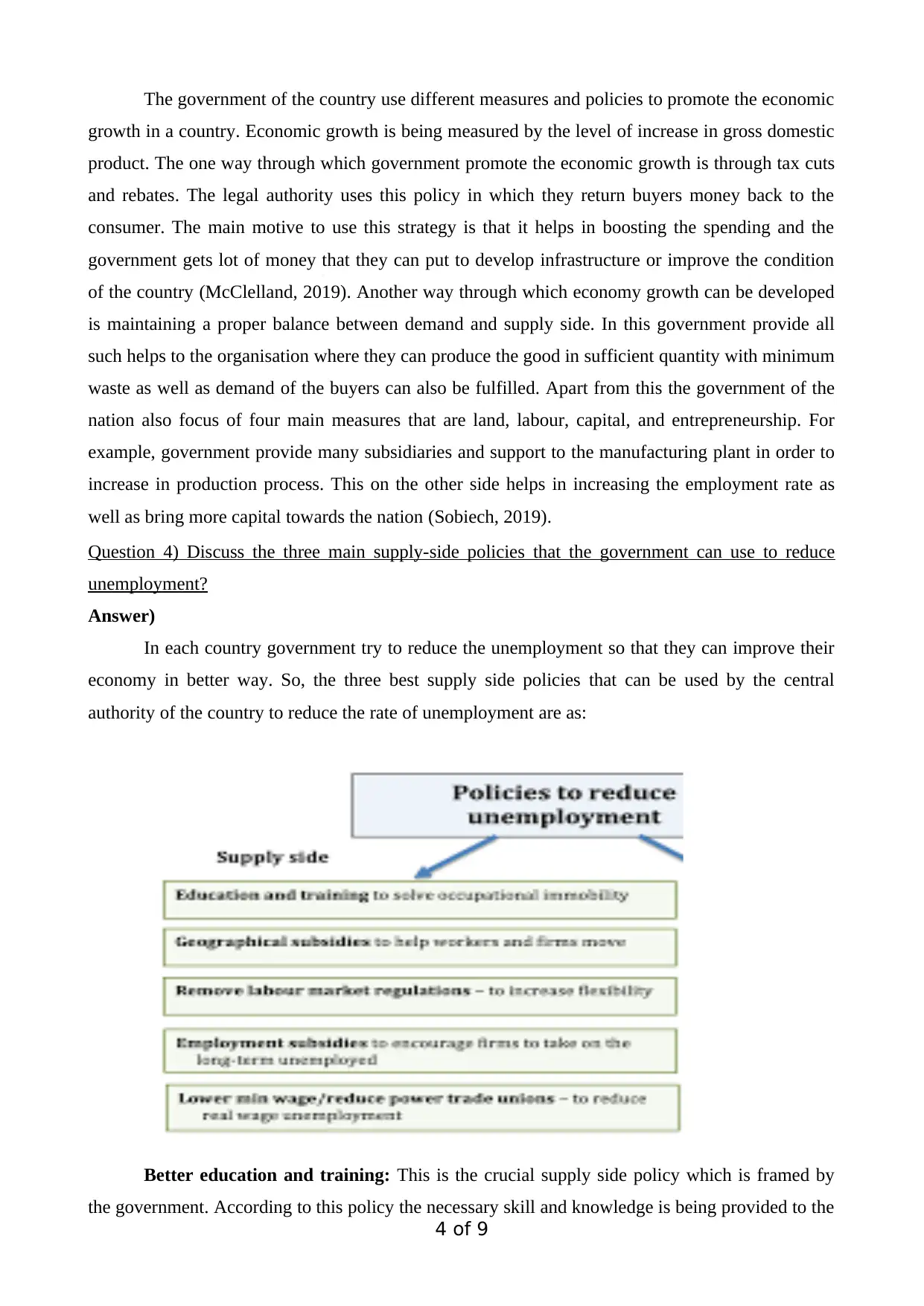
The government of the country use different measures and policies to promote the economic
growth in a country. Economic growth is being measured by the level of increase in gross domestic
product. The one way through which government promote the economic growth is through tax cuts
and rebates. The legal authority uses this policy in which they return buyers money back to the
consumer. The main motive to use this strategy is that it helps in boosting the spending and the
government gets lot of money that they can put to develop infrastructure or improve the condition
of the country (McClelland, 2019). Another way through which economy growth can be developed
is maintaining a proper balance between demand and supply side. In this government provide all
such helps to the organisation where they can produce the good in sufficient quantity with minimum
waste as well as demand of the buyers can also be fulfilled. Apart from this the government of the
nation also focus of four main measures that are land, labour, capital, and entrepreneurship. For
example, government provide many subsidiaries and support to the manufacturing plant in order to
increase in production process. This on the other side helps in increasing the employment rate as
well as bring more capital towards the nation (Sobiech, 2019).
Question 4) Discuss the three main supply-side policies that the government can use to reduce
unemployment?
Answer)
In each country government try to reduce the unemployment so that they can improve their
economy in better way. So, the three best supply side policies that can be used by the central
authority of the country to reduce the rate of unemployment are as:
Better education and training: This is the crucial supply side policy which is framed by
the government. According to this policy the necessary skill and knowledge is being provided to the
4 of 9
growth in a country. Economic growth is being measured by the level of increase in gross domestic
product. The one way through which government promote the economic growth is through tax cuts
and rebates. The legal authority uses this policy in which they return buyers money back to the
consumer. The main motive to use this strategy is that it helps in boosting the spending and the
government gets lot of money that they can put to develop infrastructure or improve the condition
of the country (McClelland, 2019). Another way through which economy growth can be developed
is maintaining a proper balance between demand and supply side. In this government provide all
such helps to the organisation where they can produce the good in sufficient quantity with minimum
waste as well as demand of the buyers can also be fulfilled. Apart from this the government of the
nation also focus of four main measures that are land, labour, capital, and entrepreneurship. For
example, government provide many subsidiaries and support to the manufacturing plant in order to
increase in production process. This on the other side helps in increasing the employment rate as
well as bring more capital towards the nation (Sobiech, 2019).
Question 4) Discuss the three main supply-side policies that the government can use to reduce
unemployment?
Answer)
In each country government try to reduce the unemployment so that they can improve their
economy in better way. So, the three best supply side policies that can be used by the central
authority of the country to reduce the rate of unemployment are as:
Better education and training: This is the crucial supply side policy which is framed by
the government. According to this policy the necessary skill and knowledge is being provided to the
4 of 9
Secure Best Marks with AI Grader
Need help grading? Try our AI Grader for instant feedback on your assignments.
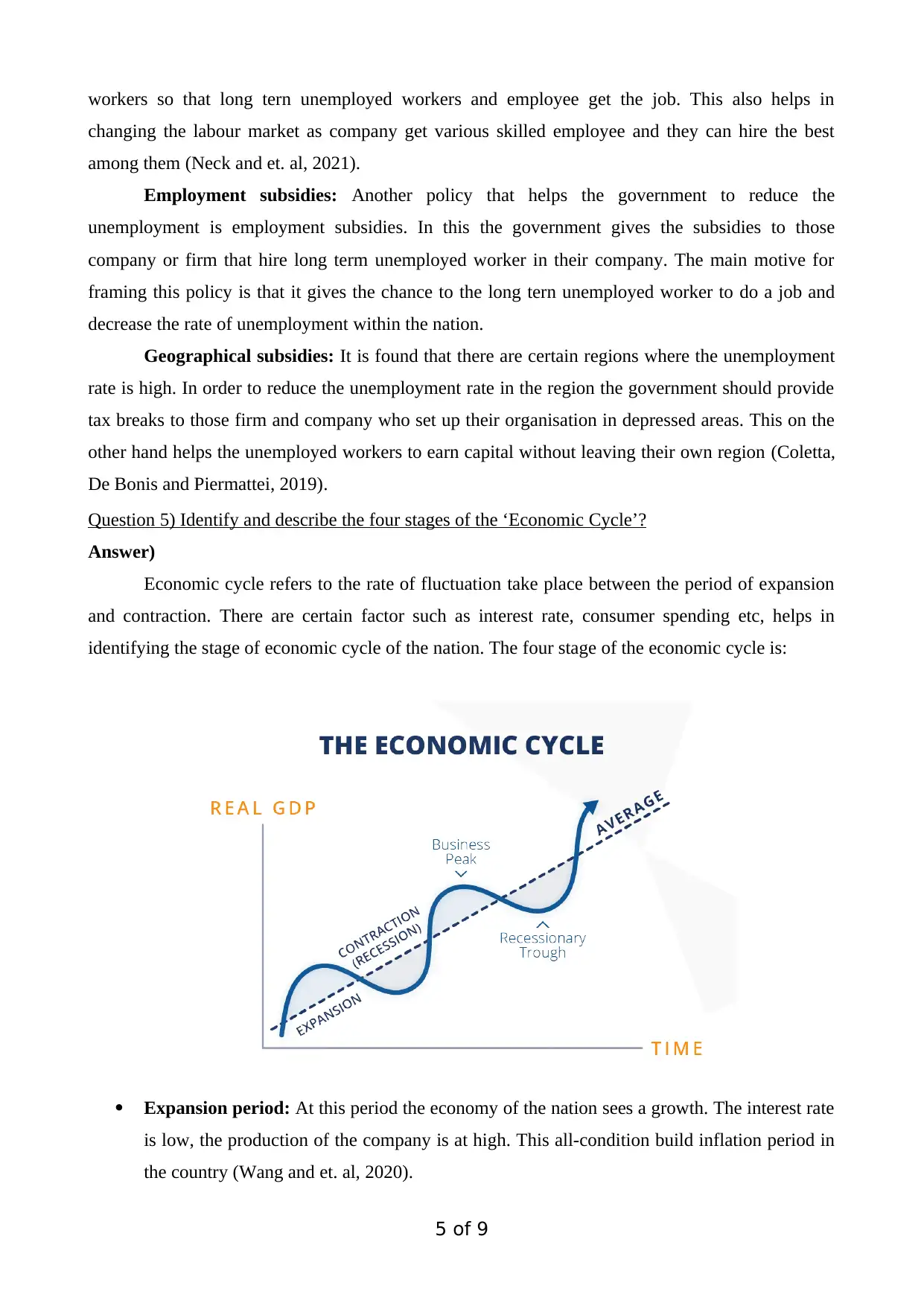
workers so that long tern unemployed workers and employee get the job. This also helps in
changing the labour market as company get various skilled employee and they can hire the best
among them (Neck and et. al, 2021).
Employment subsidies: Another policy that helps the government to reduce the
unemployment is employment subsidies. In this the government gives the subsidies to those
company or firm that hire long term unemployed worker in their company. The main motive for
framing this policy is that it gives the chance to the long tern unemployed worker to do a job and
decrease the rate of unemployment within the nation.
Geographical subsidies: It is found that there are certain regions where the unemployment
rate is high. In order to reduce the unemployment rate in the region the government should provide
tax breaks to those firm and company who set up their organisation in depressed areas. This on the
other hand helps the unemployed workers to earn capital without leaving their own region (Coletta,
De Bonis and Piermattei, 2019).
Question 5) Identify and describe the four stages of the ‘Economic Cycle’?
Answer)
Economic cycle refers to the rate of fluctuation take place between the period of expansion
and contraction. There are certain factor such as interest rate, consumer spending etc, helps in
identifying the stage of economic cycle of the nation. The four stage of the economic cycle is:
Expansion period: At this period the economy of the nation sees a growth. The interest rate
is low, the production of the company is at high. This all-condition build inflation period in
the country (Wang and et. al, 2020).
5 of 9
changing the labour market as company get various skilled employee and they can hire the best
among them (Neck and et. al, 2021).
Employment subsidies: Another policy that helps the government to reduce the
unemployment is employment subsidies. In this the government gives the subsidies to those
company or firm that hire long term unemployed worker in their company. The main motive for
framing this policy is that it gives the chance to the long tern unemployed worker to do a job and
decrease the rate of unemployment within the nation.
Geographical subsidies: It is found that there are certain regions where the unemployment
rate is high. In order to reduce the unemployment rate in the region the government should provide
tax breaks to those firm and company who set up their organisation in depressed areas. This on the
other hand helps the unemployed workers to earn capital without leaving their own region (Coletta,
De Bonis and Piermattei, 2019).
Question 5) Identify and describe the four stages of the ‘Economic Cycle’?
Answer)
Economic cycle refers to the rate of fluctuation take place between the period of expansion
and contraction. There are certain factor such as interest rate, consumer spending etc, helps in
identifying the stage of economic cycle of the nation. The four stage of the economic cycle is:
Expansion period: At this period the economy of the nation sees a growth. The interest rate
is low, the production of the company is at high. This all-condition build inflation period in
the country (Wang and et. al, 2020).
5 of 9
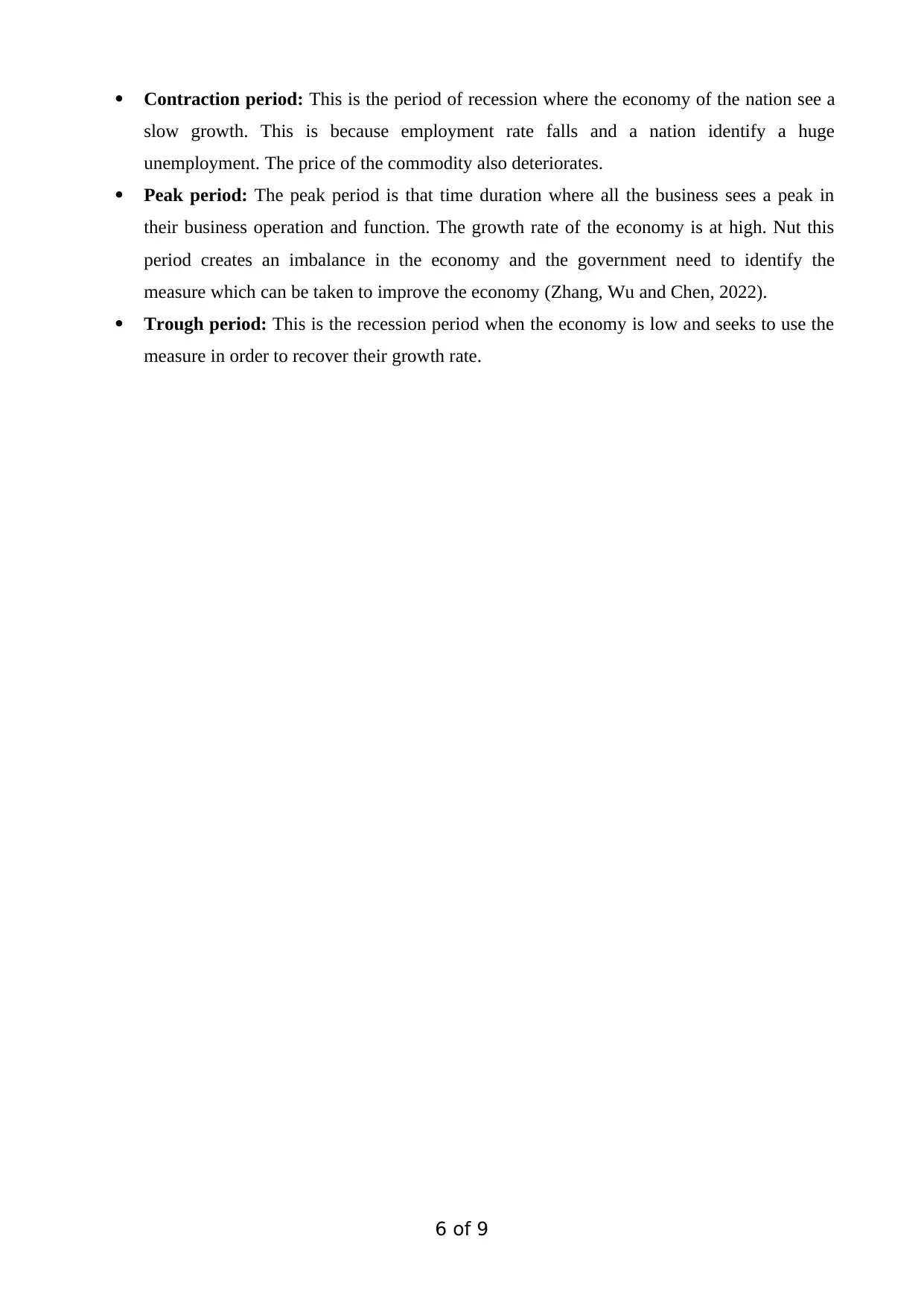
Contraction period: This is the period of recession where the economy of the nation see a
slow growth. This is because employment rate falls and a nation identify a huge
unemployment. The price of the commodity also deteriorates.
Peak period: The peak period is that time duration where all the business sees a peak in
their business operation and function. The growth rate of the economy is at high. Nut this
period creates an imbalance in the economy and the government need to identify the
measure which can be taken to improve the economy (Zhang, Wu and Chen, 2022).
Trough period: This is the recession period when the economy is low and seeks to use the
measure in order to recover their growth rate.
6 of 9
slow growth. This is because employment rate falls and a nation identify a huge
unemployment. The price of the commodity also deteriorates.
Peak period: The peak period is that time duration where all the business sees a peak in
their business operation and function. The growth rate of the economy is at high. Nut this
period creates an imbalance in the economy and the government need to identify the
measure which can be taken to improve the economy (Zhang, Wu and Chen, 2022).
Trough period: This is the recession period when the economy is low and seeks to use the
measure in order to recover their growth rate.
6 of 9
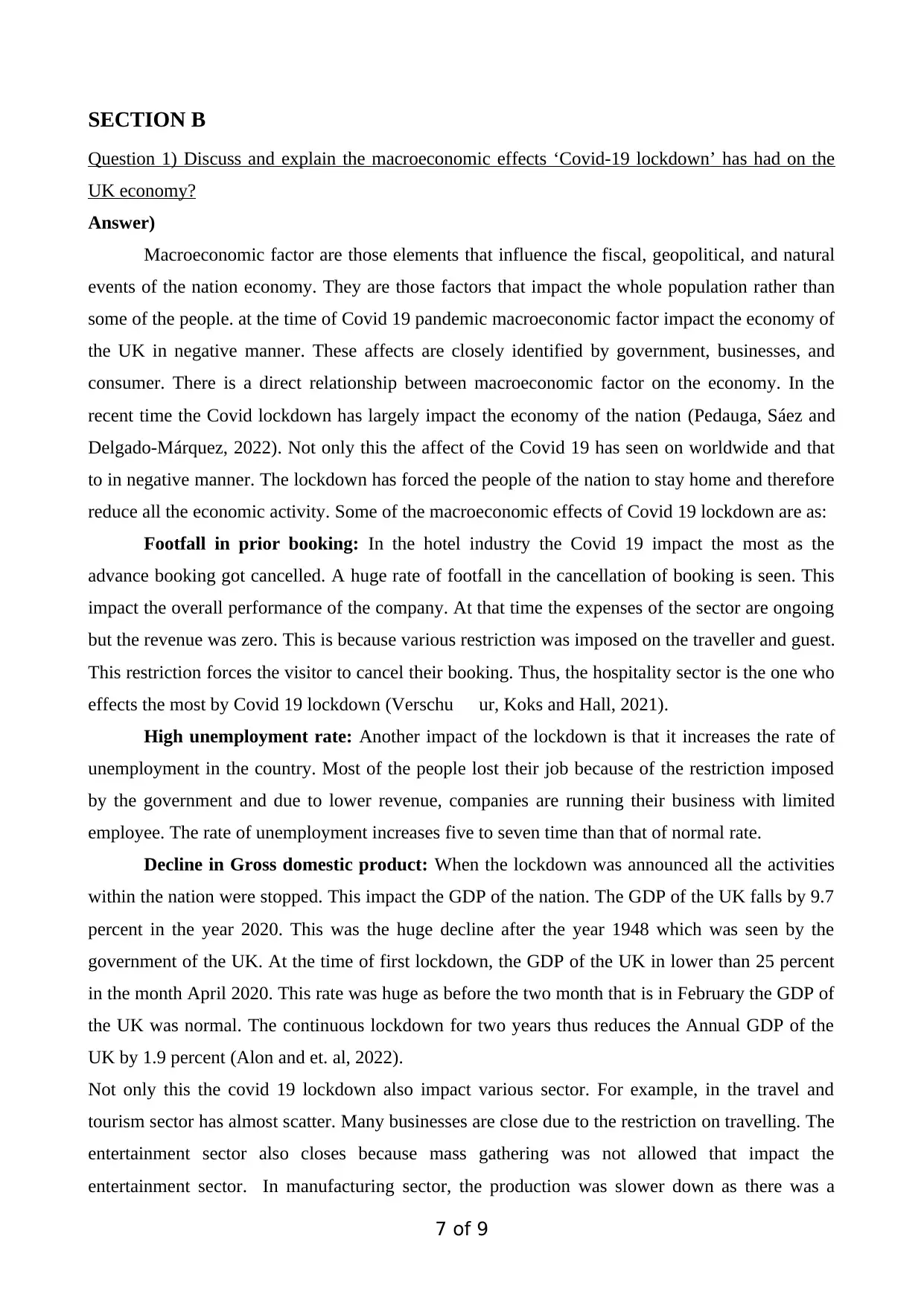
SECTION B
Question 1) Discuss and explain the macroeconomic effects ‘Covid-19 lockdown’ has had on the
UK economy?
Answer)
Macroeconomic factor are those elements that influence the fiscal, geopolitical, and natural
events of the nation economy. They are those factors that impact the whole population rather than
some of the people. at the time of Covid 19 pandemic macroeconomic factor impact the economy of
the UK in negative manner. These affects are closely identified by government, businesses, and
consumer. There is a direct relationship between macroeconomic factor on the economy. In the
recent time the Covid lockdown has largely impact the economy of the nation (Pedauga, Sáez and
Delgado-Márquez, 2022). Not only this the affect of the Covid 19 has seen on worldwide and that
to in negative manner. The lockdown has forced the people of the nation to stay home and therefore
reduce all the economic activity. Some of the macroeconomic effects of Covid 19 lockdown are as:
Footfall in prior booking: In the hotel industry the Covid 19 impact the most as the
advance booking got cancelled. A huge rate of footfall in the cancellation of booking is seen. This
impact the overall performance of the company. At that time the expenses of the sector are ongoing
but the revenue was zero. This is because various restriction was imposed on the traveller and guest.
This restriction forces the visitor to cancel their booking. Thus, the hospitality sector is the one who
effects the most by Covid 19 lockdown (Verschu ur, Koks and Hall, 2021).
High unemployment rate: Another impact of the lockdown is that it increases the rate of
unemployment in the country. Most of the people lost their job because of the restriction imposed
by the government and due to lower revenue, companies are running their business with limited
employee. The rate of unemployment increases five to seven time than that of normal rate.
Decline in Gross domestic product: When the lockdown was announced all the activities
within the nation were stopped. This impact the GDP of the nation. The GDP of the UK falls by 9.7
percent in the year 2020. This was the huge decline after the year 1948 which was seen by the
government of the UK. At the time of first lockdown, the GDP of the UK in lower than 25 percent
in the month April 2020. This rate was huge as before the two month that is in February the GDP of
the UK was normal. The continuous lockdown for two years thus reduces the Annual GDP of the
UK by 1.9 percent (Alon and et. al, 2022).
Not only this the covid 19 lockdown also impact various sector. For example, in the travel and
tourism sector has almost scatter. Many businesses are close due to the restriction on travelling. The
entertainment sector also closes because mass gathering was not allowed that impact the
entertainment sector. In manufacturing sector, the production was slower down as there was a
7 of 9
Question 1) Discuss and explain the macroeconomic effects ‘Covid-19 lockdown’ has had on the
UK economy?
Answer)
Macroeconomic factor are those elements that influence the fiscal, geopolitical, and natural
events of the nation economy. They are those factors that impact the whole population rather than
some of the people. at the time of Covid 19 pandemic macroeconomic factor impact the economy of
the UK in negative manner. These affects are closely identified by government, businesses, and
consumer. There is a direct relationship between macroeconomic factor on the economy. In the
recent time the Covid lockdown has largely impact the economy of the nation (Pedauga, Sáez and
Delgado-Márquez, 2022). Not only this the affect of the Covid 19 has seen on worldwide and that
to in negative manner. The lockdown has forced the people of the nation to stay home and therefore
reduce all the economic activity. Some of the macroeconomic effects of Covid 19 lockdown are as:
Footfall in prior booking: In the hotel industry the Covid 19 impact the most as the
advance booking got cancelled. A huge rate of footfall in the cancellation of booking is seen. This
impact the overall performance of the company. At that time the expenses of the sector are ongoing
but the revenue was zero. This is because various restriction was imposed on the traveller and guest.
This restriction forces the visitor to cancel their booking. Thus, the hospitality sector is the one who
effects the most by Covid 19 lockdown (Verschu ur, Koks and Hall, 2021).
High unemployment rate: Another impact of the lockdown is that it increases the rate of
unemployment in the country. Most of the people lost their job because of the restriction imposed
by the government and due to lower revenue, companies are running their business with limited
employee. The rate of unemployment increases five to seven time than that of normal rate.
Decline in Gross domestic product: When the lockdown was announced all the activities
within the nation were stopped. This impact the GDP of the nation. The GDP of the UK falls by 9.7
percent in the year 2020. This was the huge decline after the year 1948 which was seen by the
government of the UK. At the time of first lockdown, the GDP of the UK in lower than 25 percent
in the month April 2020. This rate was huge as before the two month that is in February the GDP of
the UK was normal. The continuous lockdown for two years thus reduces the Annual GDP of the
UK by 1.9 percent (Alon and et. al, 2022).
Not only this the covid 19 lockdown also impact various sector. For example, in the travel and
tourism sector has almost scatter. Many businesses are close due to the restriction on travelling. The
entertainment sector also closes because mass gathering was not allowed that impact the
entertainment sector. In manufacturing sector, the production was slower down as there was a
7 of 9
Paraphrase This Document
Need a fresh take? Get an instant paraphrase of this document with our AI Paraphraser
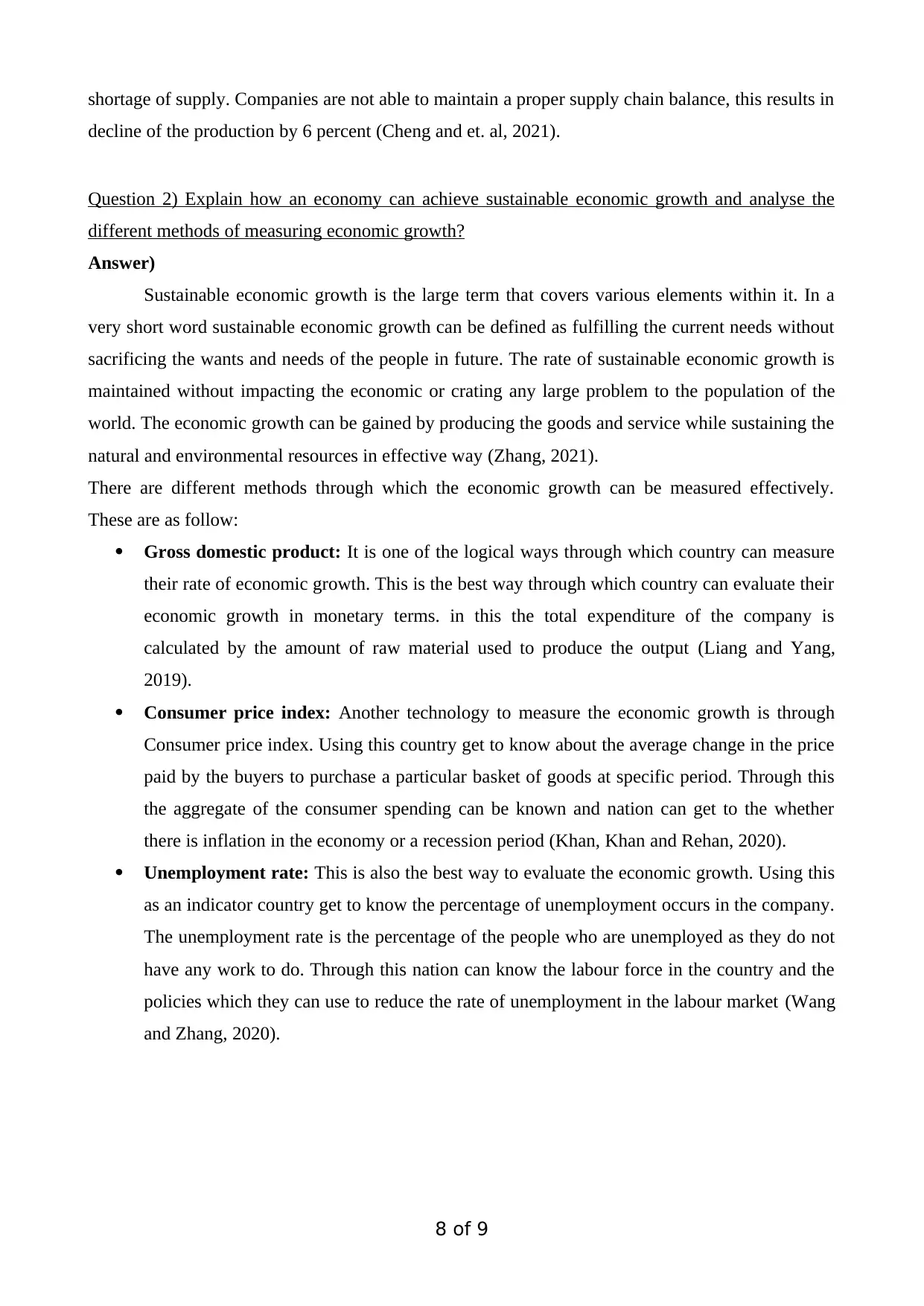
shortage of supply. Companies are not able to maintain a proper supply chain balance, this results in
decline of the production by 6 percent (Cheng and et. al, 2021).
Question 2) Explain how an economy can achieve sustainable economic growth and analyse the
different methods of measuring economic growth?
Answer)
Sustainable economic growth is the large term that covers various elements within it. In a
very short word sustainable economic growth can be defined as fulfilling the current needs without
sacrificing the wants and needs of the people in future. The rate of sustainable economic growth is
maintained without impacting the economic or crating any large problem to the population of the
world. The economic growth can be gained by producing the goods and service while sustaining the
natural and environmental resources in effective way (Zhang, 2021).
There are different methods through which the economic growth can be measured effectively.
These are as follow:
Gross domestic product: It is one of the logical ways through which country can measure
their rate of economic growth. This is the best way through which country can evaluate their
economic growth in monetary terms. in this the total expenditure of the company is
calculated by the amount of raw material used to produce the output (Liang and Yang,
2019).
Consumer price index: Another technology to measure the economic growth is through
Consumer price index. Using this country get to know about the average change in the price
paid by the buyers to purchase a particular basket of goods at specific period. Through this
the aggregate of the consumer spending can be known and nation can get to the whether
there is inflation in the economy or a recession period (Khan, Khan and Rehan, 2020).
Unemployment rate: This is also the best way to evaluate the economic growth. Using this
as an indicator country get to know the percentage of unemployment occurs in the company.
The unemployment rate is the percentage of the people who are unemployed as they do not
have any work to do. Through this nation can know the labour force in the country and the
policies which they can use to reduce the rate of unemployment in the labour market (Wang
and Zhang, 2020).
8 of 9
decline of the production by 6 percent (Cheng and et. al, 2021).
Question 2) Explain how an economy can achieve sustainable economic growth and analyse the
different methods of measuring economic growth?
Answer)
Sustainable economic growth is the large term that covers various elements within it. In a
very short word sustainable economic growth can be defined as fulfilling the current needs without
sacrificing the wants and needs of the people in future. The rate of sustainable economic growth is
maintained without impacting the economic or crating any large problem to the population of the
world. The economic growth can be gained by producing the goods and service while sustaining the
natural and environmental resources in effective way (Zhang, 2021).
There are different methods through which the economic growth can be measured effectively.
These are as follow:
Gross domestic product: It is one of the logical ways through which country can measure
their rate of economic growth. This is the best way through which country can evaluate their
economic growth in monetary terms. in this the total expenditure of the company is
calculated by the amount of raw material used to produce the output (Liang and Yang,
2019).
Consumer price index: Another technology to measure the economic growth is through
Consumer price index. Using this country get to know about the average change in the price
paid by the buyers to purchase a particular basket of goods at specific period. Through this
the aggregate of the consumer spending can be known and nation can get to the whether
there is inflation in the economy or a recession period (Khan, Khan and Rehan, 2020).
Unemployment rate: This is also the best way to evaluate the economic growth. Using this
as an indicator country get to know the percentage of unemployment occurs in the company.
The unemployment rate is the percentage of the people who are unemployed as they do not
have any work to do. Through this nation can know the labour force in the country and the
policies which they can use to reduce the rate of unemployment in the labour market (Wang
and Zhang, 2020).
8 of 9
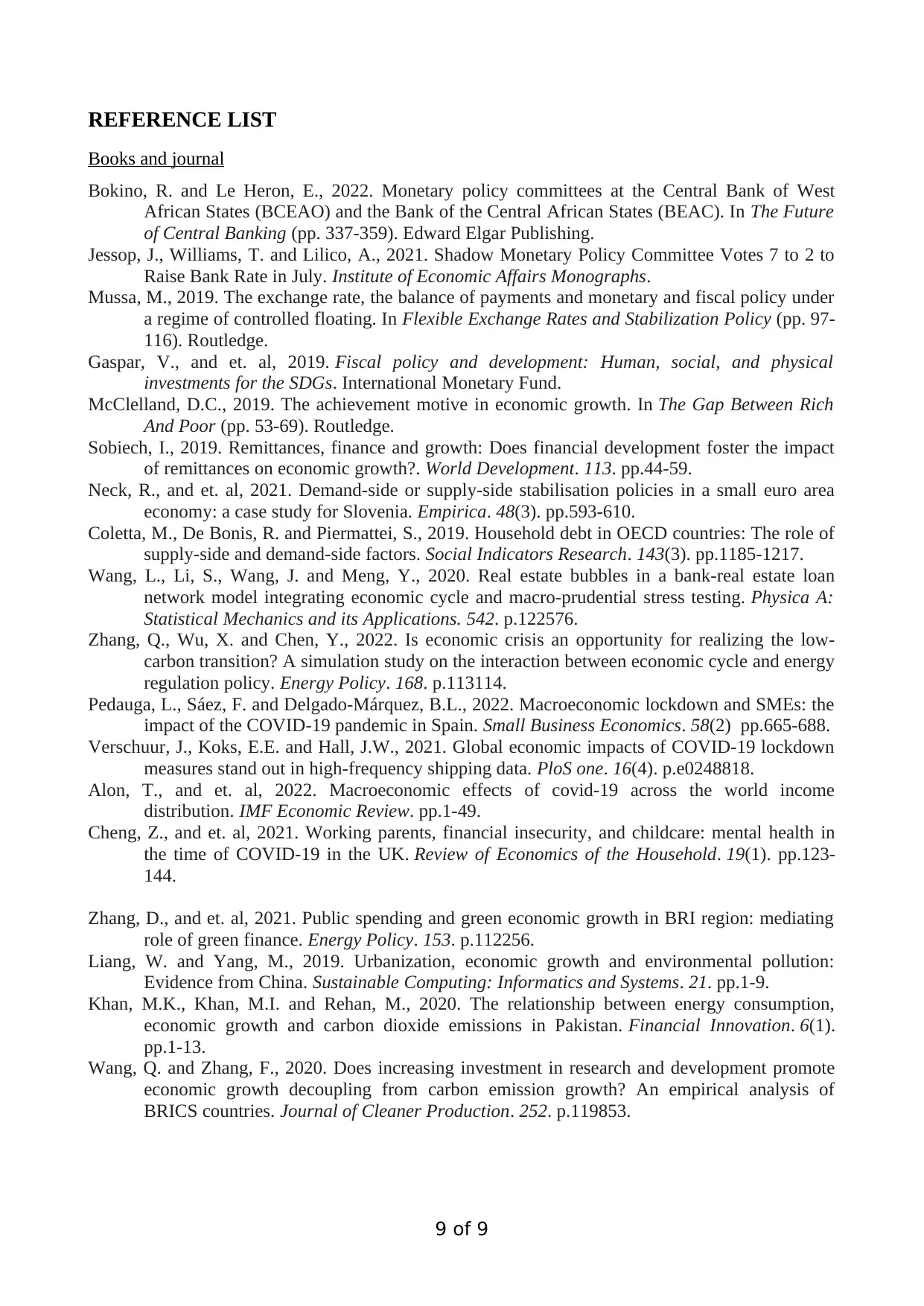
REFERENCE LIST
Books and journal
Bokino, R. and Le Heron, E., 2022. Monetary policy committees at the Central Bank of West
African States (BCEAO) and the Bank of the Central African States (BEAC). In The Future
of Central Banking (pp. 337-359). Edward Elgar Publishing.
Jessop, J., Williams, T. and Lilico, A., 2021. Shadow Monetary Policy Committee Votes 7 to 2 to
Raise Bank Rate in July. Institute of Economic Affairs Monographs.
Mussa, M., 2019. The exchange rate, the balance of payments and monetary and fiscal policy under
a regime of controlled floating. In Flexible Exchange Rates and Stabilization Policy (pp. 97-
116). Routledge.
Gaspar, V., and et. al, 2019. Fiscal policy and development: Human, social, and physical
investments for the SDGs. International Monetary Fund.
McClelland, D.C., 2019. The achievement motive in economic growth. In The Gap Between Rich
And Poor (pp. 53-69). Routledge.
Sobiech, I., 2019. Remittances, finance and growth: Does financial development foster the impact
of remittances on economic growth?. World Development. 113. pp.44-59.
Neck, R., and et. al, 2021. Demand-side or supply-side stabilisation policies in a small euro area
economy: a case study for Slovenia. Empirica. 48(3). pp.593-610.
Coletta, M., De Bonis, R. and Piermattei, S., 2019. Household debt in OECD countries: The role of
supply-side and demand-side factors. Social Indicators Research. 143(3). pp.1185-1217.
Wang, L., Li, S., Wang, J. and Meng, Y., 2020. Real estate bubbles in a bank-real estate loan
network model integrating economic cycle and macro-prudential stress testing. Physica A:
Statistical Mechanics and its Applications. 542. p.122576.
Zhang, Q., Wu, X. and Chen, Y., 2022. Is economic crisis an opportunity for realizing the low-
carbon transition? A simulation study on the interaction between economic cycle and energy
regulation policy. Energy Policy. 168. p.113114.
Pedauga, L., Sáez, F. and Delgado-Márquez, B.L., 2022. Macroeconomic lockdown and SMEs: the
impact of the COVID-19 pandemic in Spain. Small Business Economics. 58(2) pp.665-688.
Verschuur, J., Koks, E.E. and Hall, J.W., 2021. Global economic impacts of COVID-19 lockdown
measures stand out in high-frequency shipping data. PloS one. 16(4). p.e0248818.
Alon, T., and et. al, 2022. Macroeconomic effects of covid-19 across the world income
distribution. IMF Economic Review. pp.1-49.
Cheng, Z., and et. al, 2021. Working parents, financial insecurity, and childcare: mental health in
the time of COVID-19 in the UK. Review of Economics of the Household. 19(1). pp.123-
144.
Zhang, D., and et. al, 2021. Public spending and green economic growth in BRI region: mediating
role of green finance. Energy Policy. 153. p.112256.
Liang, W. and Yang, M., 2019. Urbanization, economic growth and environmental pollution:
Evidence from China. Sustainable Computing: Informatics and Systems. 21. pp.1-9.
Khan, M.K., Khan, M.I. and Rehan, M., 2020. The relationship between energy consumption,
economic growth and carbon dioxide emissions in Pakistan. Financial Innovation. 6(1).
pp.1-13.
Wang, Q. and Zhang, F., 2020. Does increasing investment in research and development promote
economic growth decoupling from carbon emission growth? An empirical analysis of
BRICS countries. Journal of Cleaner Production. 252. p.119853.
9 of 9
Books and journal
Bokino, R. and Le Heron, E., 2022. Monetary policy committees at the Central Bank of West
African States (BCEAO) and the Bank of the Central African States (BEAC). In The Future
of Central Banking (pp. 337-359). Edward Elgar Publishing.
Jessop, J., Williams, T. and Lilico, A., 2021. Shadow Monetary Policy Committee Votes 7 to 2 to
Raise Bank Rate in July. Institute of Economic Affairs Monographs.
Mussa, M., 2019. The exchange rate, the balance of payments and monetary and fiscal policy under
a regime of controlled floating. In Flexible Exchange Rates and Stabilization Policy (pp. 97-
116). Routledge.
Gaspar, V., and et. al, 2019. Fiscal policy and development: Human, social, and physical
investments for the SDGs. International Monetary Fund.
McClelland, D.C., 2019. The achievement motive in economic growth. In The Gap Between Rich
And Poor (pp. 53-69). Routledge.
Sobiech, I., 2019. Remittances, finance and growth: Does financial development foster the impact
of remittances on economic growth?. World Development. 113. pp.44-59.
Neck, R., and et. al, 2021. Demand-side or supply-side stabilisation policies in a small euro area
economy: a case study for Slovenia. Empirica. 48(3). pp.593-610.
Coletta, M., De Bonis, R. and Piermattei, S., 2019. Household debt in OECD countries: The role of
supply-side and demand-side factors. Social Indicators Research. 143(3). pp.1185-1217.
Wang, L., Li, S., Wang, J. and Meng, Y., 2020. Real estate bubbles in a bank-real estate loan
network model integrating economic cycle and macro-prudential stress testing. Physica A:
Statistical Mechanics and its Applications. 542. p.122576.
Zhang, Q., Wu, X. and Chen, Y., 2022. Is economic crisis an opportunity for realizing the low-
carbon transition? A simulation study on the interaction between economic cycle and energy
regulation policy. Energy Policy. 168. p.113114.
Pedauga, L., Sáez, F. and Delgado-Márquez, B.L., 2022. Macroeconomic lockdown and SMEs: the
impact of the COVID-19 pandemic in Spain. Small Business Economics. 58(2) pp.665-688.
Verschuur, J., Koks, E.E. and Hall, J.W., 2021. Global economic impacts of COVID-19 lockdown
measures stand out in high-frequency shipping data. PloS one. 16(4). p.e0248818.
Alon, T., and et. al, 2022. Macroeconomic effects of covid-19 across the world income
distribution. IMF Economic Review. pp.1-49.
Cheng, Z., and et. al, 2021. Working parents, financial insecurity, and childcare: mental health in
the time of COVID-19 in the UK. Review of Economics of the Household. 19(1). pp.123-
144.
Zhang, D., and et. al, 2021. Public spending and green economic growth in BRI region: mediating
role of green finance. Energy Policy. 153. p.112256.
Liang, W. and Yang, M., 2019. Urbanization, economic growth and environmental pollution:
Evidence from China. Sustainable Computing: Informatics and Systems. 21. pp.1-9.
Khan, M.K., Khan, M.I. and Rehan, M., 2020. The relationship between energy consumption,
economic growth and carbon dioxide emissions in Pakistan. Financial Innovation. 6(1).
pp.1-13.
Wang, Q. and Zhang, F., 2020. Does increasing investment in research and development promote
economic growth decoupling from carbon emission growth? An empirical analysis of
BRICS countries. Journal of Cleaner Production. 252. p.119853.
9 of 9
1 out of 9
Related Documents
Your All-in-One AI-Powered Toolkit for Academic Success.
+13062052269
info@desklib.com
Available 24*7 on WhatsApp / Email
![[object Object]](/_next/static/media/star-bottom.7253800d.svg)
Unlock your academic potential
© 2024 | Zucol Services PVT LTD | All rights reserved.

